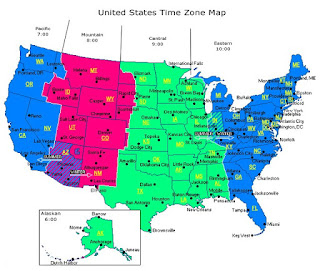EST and EDT, PST and PDT: Just say no!
 On Monday, a colleague on the East Coast asked me to call him at 12:30 EST.
On Monday, a colleague on the East Coast asked me to call him at 12:30 EST.
EST means Eastern Standard Time. However, in the United States, we’re not using Eastern Standard Time, which is the time used in the fall and winter. We’re currently using Eastern Daylight Savings Time, or EDT. That’s an hour different than EST.
What mattered is that my colleague was specifying that the call time was at 12:30 in the afternoon in his New York time zone, and thus 9:30 in the morning in my California time zone. He was making sure that I didn’t think he meant 12:30 in California, and 3:30 in New York. Standard Time and Daylight Savings Time were irrelevant in that context.
My colleague probably didn’t remember (as many people don’t remember) whether Standard Time is what we use in the winter or in the summer. Why not? Because it doesn’t matter! All we care about is that New York is three hours ahead of California, and that London is usually five hours ahead of New York (except when it’s six hours ahead, of course). The names are irrelevant.
My friends, unless you truly and deliberately mean “Standard Time,” don’t write EST, CST, MST or PST.
Similarly, unless you truly and deliberately mean “Daylight Savings Time,” don’t write EDT, CDT, MDT or PDT.
You might think I’m being pedantic, which dictionary.com describes as “overly concerned with minute details or formalisms,” Well, maybe. That’s not the point. If you think that it doesn’t matter if someone confuses EST and EDT — I agree with you. So, if it doesn’t matter, why specify the S or the D?
Recently, I received an invitation to a webinar. The webinar landing/registration page listed the start time as 1:00 EST / 10:00 PST. That was in July — again, during the months where we don’t use Eastern Standard Time or Pacific Standard Time.
What do I recommend instead? Spell out the time zone’s name. Ignore the designations for Standard or Daylight Savings. Ignore the three-letter abbreviations.
Thus, invite me to a meeting at 12:30 Eastern. Start the webinar at 1:00 Eastern / 10:00 Pacific. Everyone will know what you mean — especially those outside the United States, for whom EST, EDT, PST and PDT are just a bunch of letters.
Thank you for listening!

Why are there 4 Time Zones delineated on a map – Pacific, Mountain, Central and Eastern and yet there is only a 3 hour difference between Pacific Time and Eastern Time? Who decided to combine Mountain and Cental Time into one category when their geography, like from Nevada to Ohio is so far apart? The Pacific Time Zone is only 4 states, three which cover the actual Pacific Ocean and then randomly include Nevada. Can someone explain the rationale for the expansive Central Time Zone and why the so called Mountain Time Zone is called a Zone but is always lumped in to the Central zone. I have wondered all my life about this and would love an explanation. Thank you.